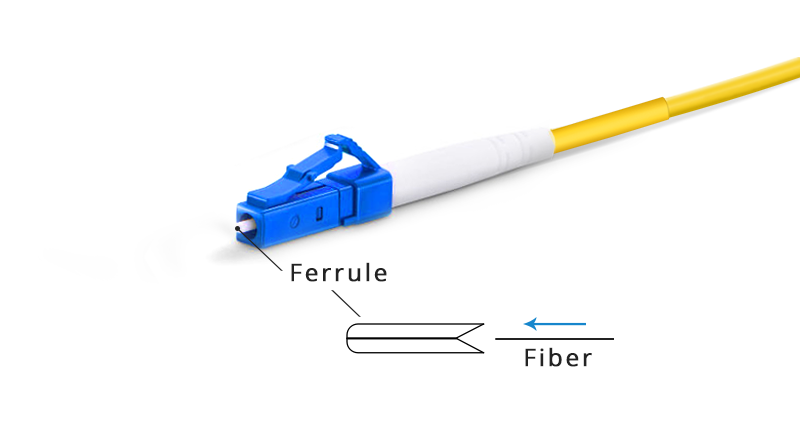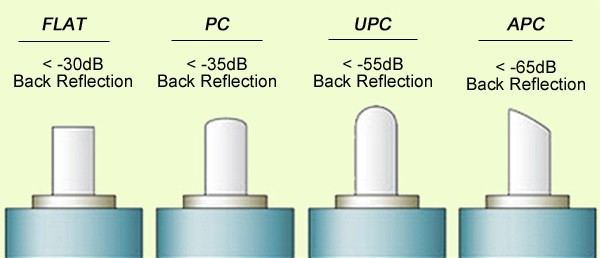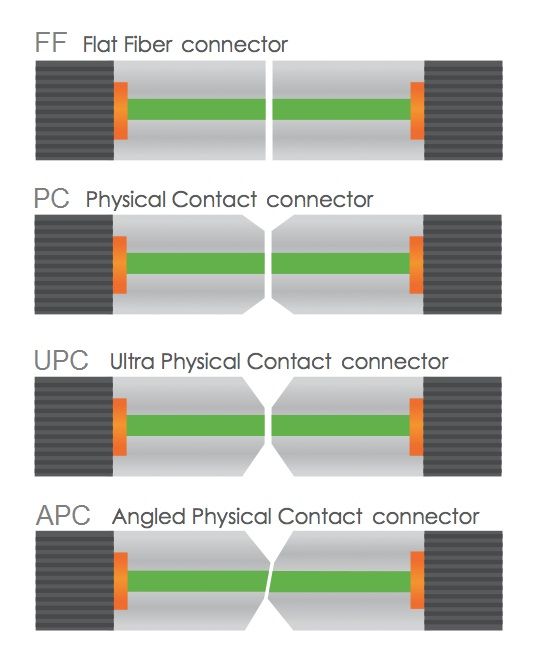When you wholesale or customize a fiber optic pigtail or fiber patch cables from suppliers in China, You may get reply quickly with questions like ” what fiber connectors do you need?”, ” what about the polishing type for the sc fiber connectors?” Frankly speaking, Polishing types in the inside ferrule matters a lot in fiber optic connection. This post we will introduce you the details about them with images and tables.

Types of Fiber Connector Polishing
There are 3 main fiber connector ferrule polishes used in today’s fiber optic applications.
- PC (Physical Contact)
- UPC (Ultra Physical Contact)
- APC (Angled Physical Contact)

Polishing Type Compared
| Polishing Type | PC (Physical Contact) | UPC (Ultra Physical Contact) | APC (Angled Physical Contact) |
|---|---|---|---|
| Description | Slight curvature on the end face of the ferrule for core-to-core alignment. | Enhanced flatness and smoother finish than PC, reducing back reflection. | Features an 8-degree angle polish on the ferrule end, minimizing back reflection. |
| Insertion Loss | Typically 0.2 – 0.5 dB | Typically 0.2 – 0.5 dB | Typically 0.2 – 0.5 dB |
| Return Loss | Usually >50 dB | Usually >50 dB | Usually >60 dB |
| Applications | Common in general applications, multimode networks. | Widely used in CATV, LAN, and telecom networks. | Ideal for high-bandwidth and long-distance applications, such as video and telephony. |
| Sensitivity to Dust | More susceptible to dust and dirt, can affect signal quality. | Less sensitive to dust compared to PC, maintaining performance. | Least sensitive to dust due to the angled polish, ensuring consistent signal quality. |
| Ferrule End | Flat end face | Flat end face | Angled (typically 8 degrees) end face |
| Key Features | Widely used, cost-effective, suitable for many applications. | Improved performance over PC, reduced back reflection. | Superior return loss, ideal for demanding applica |
How to Choose PC, UPC, and APC polishing types?

Fiber optic connectors are designed and polished to different shapes to minimize back reflection, which is particularly important in single mode applications. According to this connector polish types, there are PC, UPC, and APC fiber patch cords.
PC vs UPC vs APC Connector: Selecting the Right Fiber Connector Type presents the difference of PC, UPC, and APC. Nowadays PC polish type has been replaced by UPC type. Whether you choose UPC or APC depends on your actual application.
Since APC provides less insertion loss than UPC, the APC fiber patch cables are more applicable for high bandwidth applications and long-distance links, such as FTTx, passive optical network (PON) and wavelength division multiplex (WDM).
Whereas UPC fiber patch cords apply to optical systems that are less sensitive to insertion loss such as digital TV and telephony.
What fiber connectors have UPC PC and APC connector types?
No all fiber connectors work with this 3 main polishing types, Here you can refer to the simple table to know a complete idea about connectors, polishing type with fiber mode at different colors. These would happen in many types of fiber optic connections.
| Connector Type | Polishing Type | Mode | Color |
|---|---|---|---|
| SC | UPC | Single-mode | Blue |
| Multimode | Beige | ||
| PC | Single-mode | Blue | |
| Multimode | Beige | ||
| APC | Single-mode | Green | |
| Multimode | N/A | ||
| LC | UPC | Single-mode | Blue |
| Multimode | Beige | ||
| PC | Single-mode | Blue | |
| Multimode | Beige | ||
| APC | Single-mode | Green | |
| Multimode | N/A | ||
| FC | UPC | Single-mode | Green |
| Multimode | N/A | ||
| PC | Single-mode | Green | |
| Multimode | N/A | ||
| APC | Single-mode | Green | |
| Multimode | N/A | ||
| ST | UPC | Single-mode | Black |
| Multimode | N/A | ||
| PC | Single-mode | Black | |
| Multimode | N/A | ||
| APC | Single-mode | Green | |
| Multimode | N/A | ||
| MTP/MPO | UPC | Single-mode | Yellow |
| Multimode | Aqua | ||
| PC | Single-mode | Yellow | |
| Multimode | Aqua | ||
| APC | Single-mode | Green | |
| Multimode | N/A | ||
| MT-RJ | PC | Single-mode | Blue |
| Multimode | Beige | ||
| SC | APC | Single-mode | Green |
| Multimode | N/A | ||
| LC | APC | Single-mode | Green |
| Multimode | N/A | ||
| FC | APC | Single-mode | Green |
| Multimode | N/A |
Application of PC vs UPC vs APC Polishing Types
Some applications are more sensitive to return loss than others; they call for APC connectors. For example, in higher optical wavelength ranges (above 1500 nanometers) like those used for RF video signals, reflected light can adversely impact the signal. That is why we see APC connectors being used by most cable companies and other FTTX providers in outside plant applications.
APC connectors are also commonly used in passive optical applications (both GPONs and passive optical LANs) due to the fact that many of these systems also use RF signals to deliver video. Future higher-speed passive optical networks and other WDM applications that will use higher wavelengths via singlemode fiber will also likely require the reduced return loss of APC connectors.
One thing that should be noted is that APC and UPC connectors cannot and should not be mated. Not only does mating cause poor performance because the fiber cores will not touch, but it can also destroy both connectors. The last thing you want to do is cause permanent transmitter damage—especially with higher-cost singlemode equipment.
Another important point: Cable loss is typically the smallest contributor to system attenuation. The largest loss comes from the connector. Higher-performing connectors offer dB savings that are more significant, measurable and consistent.